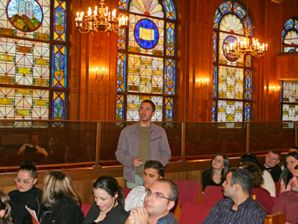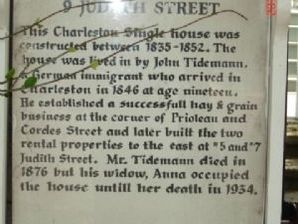Memorials

The Jewish Center of Coney Island created a social and cultural hub for the Jewish population in New York who wanted to celebrate their heritage. The programs run when this building was constructed were modeled after similar Christian associations of the time such as the YMCA. Thus, The Jewish Center of Coney Island was a place where there was a balance between religion, school, and community without secular boundaries.

This Charleston Single house was constructed between 1835-1852. The house was lived in by John Tidemann, a German immigrant who arrived in Charleston in 1846 at age nineteen. He established a successful hay & grain business at the corner of Prioleau and Cordes Street and later built the two rental properties to the east at #5 and #7 Judith Street. Mr Tidemann died in 1876 but his widow, Anna occupied the house until her death in 1934.

This memorial commemorates the struggle and pain of those Irish who fled their homeland in the face of a hunger of catastrophic proportions. It celebrates their courage and honors them for opening the door for others. Their story springs from one dark period in the history of a distant island, but their journey and arrival changed the face of American life and forged an enduring link between Ireland and America.
• As it was for the Irish long ago, America remains a hopeful refuge from... Read More

In 1790 the Common Council of the City of New York authorized the removal of stone and soil from Fort George and the Grand Battery to fill in the pier line along the Battery. Beginning in 1808, the defenses of the city were extended out into the harbor through the construction of new forts on Bedloes (Liberty) Island, Ellis Island, Governor’s Island, and on an island just 200 feet off the tip of Manhattan, known as the South-West Battery. Together, these forts with their heavy armament... Read More

Horace Greeley's New York Tribune reported on the Bloomington convention for its national readership: "It was most emphatically a convention of the people, where all classes, opinions and shades of belief were represented---but all inspired with one common resolve to resist further aggressions of the slave power to the bitter end." The "shades of belief" were broad. The old Whig Party had collapsed. New movements focused on single topics. Here in Bloomington... Read More

The Mantle was commissioned in recognition of the legacy and contribution by Native American tribes in Virginia. The monument is in the shape of a Nautilus. There is a footpath and a stonewall that form the spiral shape. This shape is supposed to represent the circular dance formations that are a common theme in the American Indian culture. Native plant species are used around the memorial. The monument is embedded into the natural world and honors the significance of nature in the culture.... Read More

Beginning in 1874, hundreds of peace-loving Mennonite immigrants settled in central Kansas. They had left their former homes in Russia because a hundred-year-old immunity from established religious orthodoxy and military service was being threatened.
The Alexanderwohl community, so named because of a solicitous visit by Czar Alexander I with Prussian Mennonites in 1821, had lived happily in southern Russia for more than 50 years before coming to America. Originating in the Netherlands in the... Read More

The original Messer Building was developed by James A. Messer and occupied a portion of this site for over half a century until 1989. The Messer family, early Scottish immigrants who settled in the District of Columbia, have left their mark as skilled stone cutters on many government buildings, churches and private residences in the area. Their influence and efforts remain in areas of commerce, banking, government and civic leadership.

English on left
They came from homes still standing in Milltown and St. Stephens. They were joined by experienced textile workers from England, Scotland, America and French Canada. The included young women, recruited from small towns and villages across the Maritimes. Together with earlier immigrants from Ireland, England and Scotland, they moved to factory work from the declining lumbering and shipbuilding industries. Their sweat and toil powered the second largest cotton mill in Canada. At... Read More

The Mohawk Institute Residential School was established in 1831 for children of the Six Nations Iroquois living on the Grand River, and it was a Canadian Indian residential school in Brantford, Ontario, Canada.
